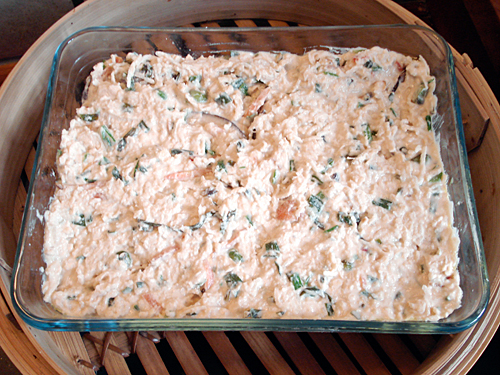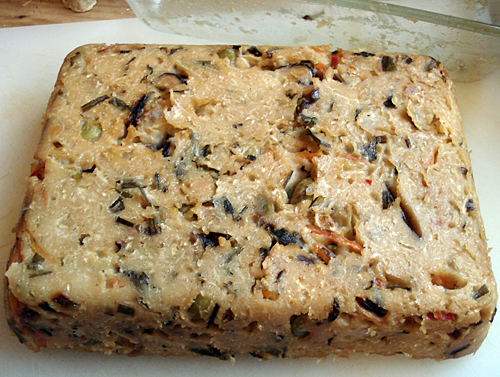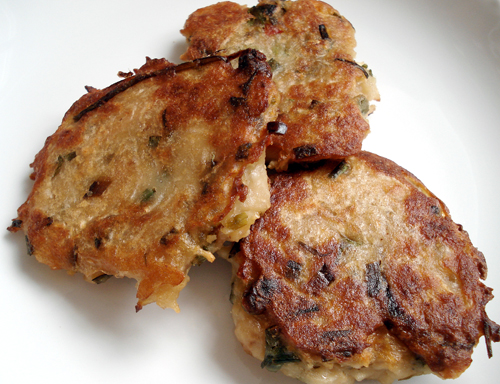Vegan Turnip Cake or Daikon Radish Cake

Turnip cake or daikon radish cake (law bock gaw in Cantonese, called daikon mochi (大根餅)in Japanese) is a staple of dim sum. It's also part of the Chinese New Year feast. It is dense, a bit sticky, and very filling.
Traditionally it's made from shredded white turnip, or more commonly from shredded daikon radish, rice flour, various shredded or chopped vegetables, plus dried shrimp, Chinese ham or bacon and/or sausage and so on, and it's fried in lard. Given that it's pretty good to eat hot or at room temperature, I tried making a vegan version, which could be the main protein in a vegan bento, or a combination protein-carb. I am pretty happy with the results.
I'll show you two ways to make this. The first is the traditional method of putting the batter into a heatproof dish or mold and to steam it for about an hour, let it cool, and then slice the cake and fry the pieces. The second method omits the steaming stage and is a lot faster. Both methods yield little cakes that are dense, filling and mochi-like on the inside with a sweetness that comes from the shredded daikon radish, and crispy-salty on the outside.
It's not exactly a quick recipe, though the second method is a lot faster. But you can make a lot of them at once and freeze the extras. Weekend project perhaps?
Vegan Daikon Radish Cake or Turnip Cake
This amount of batter will make a square cake that yields about 48 little cakes, each about 50-60 calories depending on how much oil you use to fry them in.
- 4 dried shiitake mushrooms
- 200g / 7oz (about 1 1/4 cups) rice flour (see Notes)
- 200g / 7oz (about 1 1/4 cups) sweet or glutionous rice flour or mochiko
- 1 small to medium daikon (mouli) radish, yielding about 4 cups (880ml) shredded
- 1 medium carrot, shredded
- 1 cup boiled edamame (beans only)
- 3 tablespoons white miso
- 1 tablespoon soy sauce
- 1 cup drained canned white or cannellini beans
- 1 1/2 cups chopped green onions
- 1/4 cup finely chopped cilantro (fresh coriander) leaves (optional)
- 1 Tbs. sesame oil
- Vegetable or olive oil for frying the little cakes
- Additional soy sauce or hoisin sauce, optional (use a gluten-free version if you have a problem with gluten)
Traditional long method
Equipment needed: bamboo steamer, heatproof square or circular mold, frying pan
Equipment suggested: a food processor
Soak the shiitake mushrooms in enough warm water to cover, until they are softened. (Or you can leave them overnight in the refrigerator in cold water.)
Combine the rice flours in a bowl.
Peel the daikon radish and shred them with the fine shredder attachment of a food processor, or by hand with a grater. You should end up with around 4 cups. Squeeze them out by hand and reserve the liquid.
Shred or julienne the carrot. Chop up the green onion and optional coriander finely.
Drain and squeeze out the shiitake mushrooms and reserve the soaking liquid. Te the stems off the shiitake mushrooms and slice thinly.
Heat up a wok or frying pan with the sesame oil, and briefly stir fry the vegetables, white beans and edamame (but not the the daikon) just until it's all coated with the oil and smelling very nice. You can add some red chili pepper flakes or chopped fresh chili pepper if you want some spiciness. Add the soy sauce, stir around a bit and take off the heat.
Dissolve the miso in the mushroom soaking liquid.
Stir the daikon into the rice flours. Add the mushroom soaking liquid with the dissolved miso. Add the sautéed vegetables. Add just enough of the reserved daikon liquid until the batter like a very thick pancake batter (it shouldn't be liquid-runny, but rather heavy).
Lightly oil your mold. Pour in the batter. Put the mold in the steamer. Here's how the batter looks in the mold:

Steam (don't forget to add more water if the steamer is running dry!) for 1 hour or it's firm to the touch in the middle. Take the mold out of the steamer and let cool, then refrigerate, covered, overnight. Here's how the cake looks un-molded:

Take out the cold cake, and cut with a sharp, wet knife inti squares. You can just cut off as much as you want to use at one time. Fry the squares in a little vegetable oil until golden brown on both sides.

Optionally brush the surface with a little soy sauce or hoisin sauce, or dip in some vinegar-soy sauce when eating.
The much faster method
Equipment needed: A frying pan (no steamer, mold, etc), lid
If you are thinking to yourself, Steamer? Mold? Steam 1 hour? Refrigerate overnight? No way! - there is a much easier and faster method. Just drop tablespoons of the batter onto a hot oiled frying pan, lower the heat to low, put a lid on, and steam-fry until the bottoms are a golden brown. Turn over and repeat on the other side. This only takes about 10-12 minutes, and tastes just as good, even if they aren't the traditional square shape.

If you are making the cakes with this method, you might consider halving the recipe. Extra cakes freeze very well, either after frying or before. (I prefer to fry them so they can just be defrosted quickly in a toaster oven or a dry frying pan.)
Notes
- A mixture of regular and glutinous or sweet rice flour (or mochiko) is used here for the combination of denseness and gooey-ness. You can find both at an Asian or Chinese grocery. If you are in Japan, you'll want to use joushinko (上新粉)and shiratamako (白玉粉).
- The key to converting this from the traditional omnivore version is to add as much umami as possible to the batter. This is accomplished here by adding shiitake, the soaking liquid, miso, soy sauce and sesame oil. Stir-frying the vegetables briefly also adds flavor.
- Try substituting natto for the edamame or the white beans. You can try other beans here too. The beans are there to add protein and texture.
- You can add more or other shredded or finely chopped vegetables to this.
- If you use gluten-free soy sauce and miso, this will be gluten-free.
- For a traditional omnivore version, try this recipe on Epicurious.
If you enjoyed this article, please consider supporting this site by becoming my patron via Patreon.
